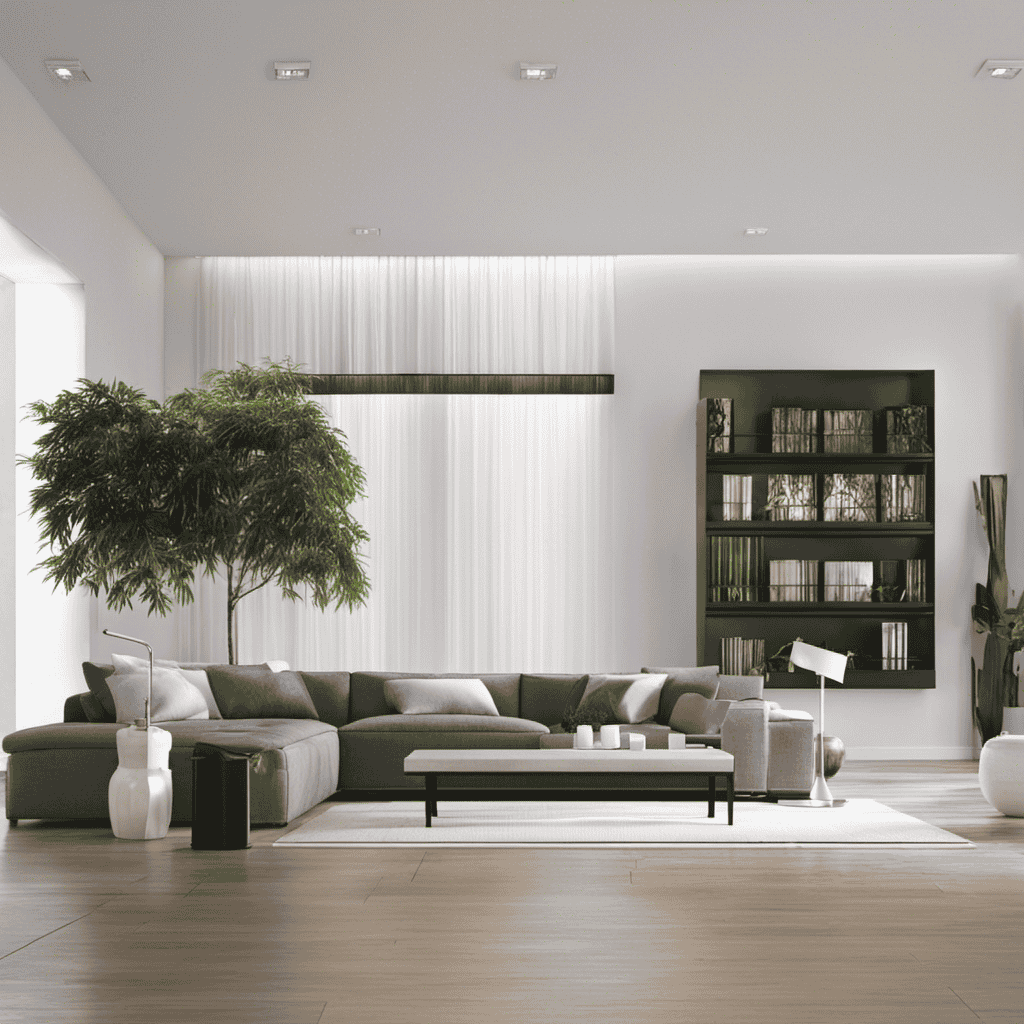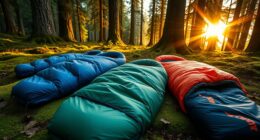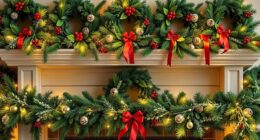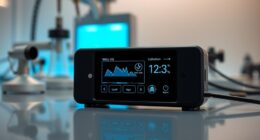Do you ever wonder where to put your **air purifier** to ensure you’re breathing cleaner air?Discover the best spot for your air purifier to maximize its effectiveness and improve your indoor air quality. Keep reading to find out why proper placement is crucial for achieving optimal results.
Well, after conducting extensive research and carefully analyzing the evidence, I am excited to share with you the definitive answer.
In this article, we’ll explore the most optimal locations for placing an air purifier, taking into account factors such as room size, air flow, obstructions, and more.
So, let’s dive in and ensure that every breath we take is as pure and refreshing as possible.
Key Takeaways
- Consider the size of the room and evaluate the air flow in the area.
- Avoid placing the purifier near obstructions and place it at a central location.
- Regular maintenance and filter replacement are crucial for the purifier’s effectiveness.
- Take into account the source of air pollution and the distance from pollutant sources.
Consider the Size of the Room
When choosing where to place an air purifier, it’s important to consider the size of the room. Evaluating the room size, dimensions, and layout can help determine the most effective placement for the air purifier. Research suggests that placing the air purifier in the middle of the room can provide optimal air circulation and coverage. This allows the purifier to effectively remove pollutants from all corners of the room.
Room dimensions play a crucial role in determining the size and power of the air purifier needed. Larger rooms require air purifiers with higher CADR (Clean Air Delivery Rate) to effectively clean the air. It is recommended to choose an air purifier that is capable of cleaning the air in the entire room within a reasonable amount of time.
Additionally, the layout of the room should be considered when placing the air purifier. Obstacles such as furniture, curtains, or walls can hinder the air circulation and reduce the purifier’s efficiency. It is important to place the purifier in an area that allows for unobstructed airflow.
Evaluate the Air Flow in the Area
When it comes to evaluating the air flow in a specific area, two key points to consider are optimal air circulation and avoiding stagnant air.
Optimal air circulation ensures that fresh air is constantly flowing throughout the space, reducing the concentration of pollutants and improving overall air quality.
On the other hand, stagnant air can lead to the accumulation of pollutants and allergens, posing potential health risks.
Therefore, understanding and managing air flow is crucial in creating a healthy and comfortable environment.
Optimal Air Circulation
For optimal air circulation, it’s best to place the air purifier in a central location within the room. This placement ensures that the purified air can circulate evenly throughout the space, maximizing its effectiveness in improving the air quality.
Research has shown that proper air circulation is crucial for maintaining optimal air quality, and this has significant health benefits. When the air purifier is placed centrally, it can effectively capture and remove pollutants from all corners of the room, reducing the risk of respiratory issues and allergies.
Additionally, placing the air purifier in a central location allows it to work efficiently by minimizing obstacles and obstructions that may impede airflow.
Avoid Stagnant Air
To prevent stagnant air, it’s important to position the air purifier in a central location within the room. This ensures that the purifier can effectively circulate the air and remove pollutants from all areas of the room. Placing the air purifier near walls or furniture can obstruct the airflow and limit its effectiveness. According to research studies, the best placement for an air purifier is in the middle of the room, at least a few feet away from any obstacles. This allows for maximum air circulation and prevents air stagnation. By maximizing the effectiveness of the air purifier, you can ensure that the air in your room remains clean and fresh.
| Obstacles | Placement | Effectiveness |
|---|---|---|
| Walls | Central | High |
| Furniture | Central | High |
| Corners | Central | High |
| Doors | Central | High |
Avoid Placing the Purifier Near Obstructions
Make sure you don’t place the air purifier near any obstructions. Research has shown that obstructions, such as furniture or walls, can hinder the efficiency of an air purifier by restricting the circulation of air. By placing the purifier near obstructions, you risk reducing its effectiveness in cleaning the air in your space.
To maximize the airflow and effectiveness of your air purifier, it is recommended to place it in an open area with sufficient space around it. This allows for better air circulation and ensures that the purifier can effectively capture and filter pollutants from the air. Additionally, placing the purifier away from obstructions can help prevent the accumulation of dust and particles on the filters, which can reduce its lifespan and overall performance.
Consider placing your air purifier in a central location in the room, away from walls, furniture, or other objects that may obstruct the airflow. This will help to ensure that the purified air is evenly distributed throughout the space, providing you with the best possible air quality.
Place the Purifier at a Central Location
When it comes to optimizing the performance of an air purifier, there are three key factors to consider: optimal room positioning, airflow and circulation, and distance from pollutant sources.
Research has shown that placing the purifier at a central location in the room allows for better distribution of clean air throughout the space.
Additionally, ensuring proper airflow and circulation in the room can help the purifier effectively capture and remove airborne pollutants.
Lastly, it is important to keep the purifier at a distance from pollutant sources, such as cooking areas or smoking zones, to prevent the contaminants from overwhelming the purifier’s capabilities.
Optimal Room Positioning
Position your air purifier in a central location within the room for optimal effectiveness. Placing the purifier in the middle of the room allows it to circulate air more efficiently, reaching all areas and providing optimal air quality.
Here are two sub-lists to further explain the importance of optimal room positioning:
-
Benefits of Central Positioning:
- Improved air circulation: Placing the purifier centrally ensures that the air is evenly distributed throughout the room, reducing the presence of pollutants.
- Enhanced filtration: With the purifier at the center, it can better capture airborne particles and pollutants, resulting in cleaner and healthier air.
-
Considerations for Placement:
- Avoid obstructions: Ensure that the purifier is not obstructed by furniture, curtains, or walls, as this can hinder its effectiveness.
- Strategic placement: Position the purifier near sources of pollutants, such as near windows to filter outdoor air or in areas with high traffic, to target specific problem areas.
Choosing the right location for your air purifier is crucial for maximizing its health benefits and optimizing air quality in your living space.
Airflow and Circulation
In order to maintain optimal performance and effectiveness of an air purifier, regular maintenance is essential. This includes cleaning the unit and replacing the filters as recommended by the manufacturer.
Air purifier filters are designed to capture and remove particles from the air, but over time, they can become clogged and lose their efficiency. Regular filter replacement ensures that the air purifier continues to effectively remove pollutants from the air, improving indoor air quality.
Additionally, cleaning the unit itself helps prevent the accumulation of dust and debris, allowing for better airflow and circulation. By following proper maintenance practices, the air purifier can continue to provide clean and fresh air for a longer period of time. This is especially important for individuals with respiratory conditions or allergies.
Transitioning to the next subtopic, the distance from pollutant sources is another important factor to consider when determining the best placement for an air purifier.
Distance From Pollutant Sources
To ensure the most effective removal of pollutants, you should consider placing your air purifier at a distance from potential sources of pollution. This includes keeping it away from windows and ensuring it is not too close to furniture.
Research has shown that placing an air purifier too close to a window can result in the intake of outdoor pollutants, such as pollen or car exhaust fumes. Similarly, placing it too close to furniture can hinder its ability to effectively circulate and filter the air.
By maintaining a suitable distance from windows and furniture, you can optimize the air purifier’s ability to capture and remove pollutants from the indoor environment.
In the next section, we will delve further into the importance of taking into account the source of air pollution when deciding on the best placement for your air purifier.
Take Into Account the Source of Air Pollution
Consider where the air pollution is coming from and place the air purifier accordingly. When determining the best location for an air purifier, it is crucial to take into account the source of air pollution.
One important factor to consider is the distance from windows. Air pollution can enter our homes through open windows, bringing in outdoor pollutants such as vehicle emissions, industrial pollutants, and allergens. Placing the air purifier near windows can help capture these pollutants before they have a chance to circulate throughout the room.
Another factor to consider is the impact on furniture. Air pollution can have detrimental effects on our furniture, causing discoloration, deterioration, and unpleasant odors. Placing the air purifier near furniture can help minimize these effects by capturing airborne particles and pollutants that can settle on surfaces. This can help prolong the lifespan of our furniture and maintain its aesthetic appeal.
Research has shown that strategically placing air purifiers in areas where pollution sources are prevalent, such as near windows and furniture, can significantly improve indoor air quality. By capturing pollutants at their source, air purifiers can help create a healthier and more comfortable living environment. Therefore, it is essential to consider where the air pollution is coming from and place the air purifier accordingly, maximizing its effectiveness in reducing indoor air pollution.
Be Mindful of Noise Levels
When it comes to air purifiers, it’s important to consider the impact of noise on sleep quality. Research has shown that excessive noise can disrupt sleep patterns and lead to poor sleep quality, which can have negative effects on overall health and well-being.
Additionally, the location of the air purifier in relation to noise sources can also play a role in its effectiveness. Placing the purifier close to a noise source, such as a loud air conditioner or a busy street, may result in the noise cancelling out the purifier’s benefits.
Therefore, it is essential to explore quiet air purifier options that prioritize noise reduction while still effectively improving air quality.
Noise and Sleep Quality
If you’re a light sleeper, you might want to avoid placing the air purifier directly in your bedroom due to the noise it can produce. Noise reduction is crucial for a good night’s sleep, and the constant humming or whirring of an air purifier can be a sleep disturbance. Research has shown that noise disturbances during sleep can lead to fragmented sleep patterns and decreased sleep quality.
To ensure a peaceful sleep environment, consider the following:
- Opt for a larger air purifier placed in a common area, such as the living room, where noise won’t impact your sleep as much.
- If you prefer having the air purifier in your bedroom, position it as far away from your bed as possible to minimize the noise disruption.
By strategically placing your air purifier, you can prioritize noise reduction and improve the quality of your sleep.
Now, let’s dive deeper into the interaction between location and noise.
Location and Noise Interaction
To maximize your sleep quality, try positioning the air purifier away from your bed to minimize any noise disturbances. Research suggests that the location of an air purifier can greatly impact its effectiveness and its impact on allergies.
Placing the air purifier in a strategic location can help ensure that it efficiently filters the air in your bedroom without causing any disruptions to your sleep. When considering the best placement for your air purifier, it is important to take into account the size of your room, the airflow patterns, and any potential sources of pollutants.
Additionally, it is recommended to avoid placing the air purifier too close to your bed, as this can lead to noise disturbances which may negatively affect your sleep quality. By positioning the air purifier in a suitable location, you can enhance its effectiveness in removing allergens and improve your overall sleep environment.
Quiet Air Purifier Options
Consider opting for a quieter air purifier model to minimize any potential noise disturbances in your bedroom. When it comes to choosing a quiet air purifier, there are several features to look out for. Here are some key points to consider:
-
Noise Level: Look for air purifiers with noise levels below 50 decibels, which is equivalent to a quiet conversation or a background noise in a library.
-
Fan Speed Settings: Opt for models that offer adjustable fan speed settings. Lowering the fan speed can help reduce noise while still maintaining effective air purification.
-
Noise Reduction Technology: Some air purifiers come with noise reduction technology, such as soundproofing materials or specially designed fans, to further minimize noise disruptions.
In addition to selecting a quiet air purifier, proper maintenance is essential for optimal performance. Regularly cleaning or replacing filters, keeping the unit dust-free, and following manufacturer’s instructions for maintenance will ensure that your air purifier operates efficiently and quietly.
Consider the Height of the Purifier
The height of the purifier matters when determining the best place to put it. To evaluate the purifier’s effectiveness, it is important to consider its height in relation to the room’s layout and airflow patterns. Research suggests that placing the purifier at a height of about 3-5 feet above the ground can optimize its performance. This height allows the purifier to effectively capture airborne particles, such as dust and allergens, that tend to settle closer to the ground. Additionally, placing the purifier at this height helps ensure that the clean air it produces is evenly distributed throughout the room.
Maintenance requirements should also be taken into account when deciding where to place the purifier. Regular maintenance, such as filter replacement and cleaning, is essential for the purifier to continue functioning effectively. Placing the purifier at a height that is easily accessible can make these maintenance tasks more convenient. It is also important to consider the purifier’s proximity to potential sources of contamination, such as pets or smokers, as these factors can impact the frequency of maintenance needed.
Take Into Account the Layout of the Room
When deciding where to position it, take into account the layout of your room. Evaluating air quality is essential in determining the best location for your air purifier. Here are some factors to consider:
-
Air Circulation: Place the air purifier in an area with proper air circulation, such as near a window or doorway. Ensure that there is enough space around the purifier for air to flow freely.
-
Proximity to Pollution Sources: Position the air purifier closer to potential pollution sources, such as a kitchen or smoking area, to effectively capture airborne particles. Avoid placing the purifier near sources of high humidity, as it can affect its performance and lifespan.
Choosing the right filter is also crucial for optimal air purification. Different filters target specific pollutants, so consider the following:
-
HEPA Filters: Highly efficient in removing allergens, dust, and pet dander from the air. Ideal for those with allergies or asthma.
-
Activated Carbon Filters: Effective in eliminating odors, smoke, and volatile organic compounds (VOCs). Suitable for households with smokers or those living in areas with high pollution levels.
Avoid Placing the Purifier Near Electronics
Avoid putting the purifier near electronics, as it can interfere with their functionality. Research has shown that air purifiers emit electromagnetic fields (EMFs) that can disrupt the performance of electronic devices. Placing the purifier too close to electronics such as televisions, computers, or gaming consoles can lead to signal interference, reduced connectivity, and even damage to these devices.
To ensure the optimal functioning of both the air purifier and electronics, it is recommended to maintain a safe distance between them. Experts suggest keeping a minimum distance of at least three feet between the purifier and any electronic equipment. This distance allows for proper ventilation and prevents the EMFs emitted by the purifier from affecting the electronics.
Additionally, it is advisable to avoid placing the purifier near windows, as this can introduce outdoor pollutants into the purifier’s airflow, potentially reducing its effectiveness in improving indoor air quality.
Be Aware of the Purifier’s Reach
It’s important to consider the purifier’s reach to ensure it effectively cleans the air in the desired area. When determining the optimal purifier size and the effectiveness of purifier placement, there are a few key factors to consider:
-
Room size: The size of the room plays a crucial role in determining the purifier’s reach. A purifier that is too small for the room may not be able to effectively clean the air, while a purifier that is too large may be unnecessary and inefficient.
-
Airflow and circulation: The placement of the purifier can affect its ability to effectively circulate and clean the air. It’s important to consider factors such as the location of doors, windows, and vents, as well as any obstacles that may hinder the airflow.
-
Proximity to pollution sources: Placing the purifier near pollution sources, such as high-traffic areas or areas with high levels of dust or allergens, can maximize its effectiveness. By targeting these specific areas, the purifier can help reduce the concentration of pollutants in the air.
Consider the Aesthetics of Placement
Consider the aesthetics of where you want to position your purifier to ensure it blends well with the overall decor of the room. When it comes to air purifiers, functionality is important, but so is the visual appeal. No one wants an eyesore in their beautifully decorated living room or bedroom. That’s why it’s crucial to choose a placement that not only maximizes the purifier’s efficiency but also complements the room’s aesthetic.
To achieve the perfect balance between aesthetics and functionality, there are a few key factors to consider. First, think about the size and style of your air purifier. If you have a small purifier, it can easily be placed on a side table or shelf without overpowering the space. On the other hand, larger purifiers may require more thought. Consider placing them in a corner or against a wall to minimize their visual impact.
Additionally, think about the color and finish of your air purifier. If you have a modern, minimalist room, a sleek black or white purifier might be the best choice. However, if your room has a more rustic or eclectic vibe, a purifier with a wood finish or a pop of color could be a great way to incorporate it into the overall decor.
Are There Different Placement Recommendations for Different Types of Air Purifiers?
Yes, there are different placement recommendations for different types of air purifiers. For example, HEPA air purifiers work best when placed in the center of a room, while carbon filter air purifiers are most effective when placed near the source of odors. Finding the best place for air purifier placement depends on the specific type of air purifier.
Frequently Asked Questions
Can I Place the Air Purifier Near a Window to Improve Air Quality?
Placing an air purifier near a window can have several benefits for improving air quality.
Air purifiers can effectively remove outdoor pollutants, such as pollen, dust, and smoke, that enter through open windows. This can help reduce allergies, asthma symptoms, and respiratory issues.
Additionally, placing the air purifier near a window allows it to capture and filter these pollutants before they spread throughout the room, providing cleaner and fresher air for you to breathe.
Is It Necessary to Move Furniture or Other Objects to Optimize Air Purification?
Moving furniture or other objects can have a significant impact on optimizing air purification. The arrangement of furniture in a room can affect the airflow and distribution of clean air throughout the space.
By strategically placing the air purifier in an area where it has unobstructed access to the room, it can effectively filter and circulate the air.
Consider rearranging furniture to create a clear path for air movement and maximize the purifier’s efficiency.
How Close Can I Place the Air Purifier to Other Appliances or Electronic Devices?
When it comes to placing an air purifier near appliances or electronic devices, it’s important to consider their proximity. The placement of the air purifier can affect its performance in removing pet dander and other pollutants from the air.
Research suggests that it’s best to keep a distance of at least three feet between the air purifier and other devices to avoid any interference. This ensures optimal air purification without any potential disruptions.
Should I Consider the Height of the Room When Deciding Where to Place the Air Purifier?
When deciding where to place an air purifier, it’s important to consider the height of the room. Higher levels of pollutants, such as dust and pet dander, tend to accumulate closer to the floor. By placing the air purifier at a higher elevation, it can effectively capture these pollutants and improve air quality throughout the room.
Additionally, it’s advisable to avoid placing the purifier near plants as they can release certain compounds that may interfere with the purifier’s performance.
Can I Place the Air Purifier in a Corner of the Room for Better Effectiveness?
Placing an air purifier in a corner of the room might seem like a great idea for better effectiveness, but it’s important to consider other factors.
Research suggests that placing the purifier near a window can enhance its performance by allowing it to capture outdoor pollutants. However, corner placement may limit the purifier’s ability to circulate air evenly throughout the room.
It’s best to find a balance between proximity to the window and ensuring proper air circulation for optimal effectiveness.
Conclusion
In conclusion, finding the best place to put an air purifier requires careful consideration of several factors.
The size of the room, air flow, obstructions, and the source of air pollution all play a role in determining the optimal location.
Additionally, the layout of the room, proximity to electronics, and the purifier’s reach should be taken into account.
It is interesting to note that according to a study conducted by the American Lung Association, indoor air can be up to five times more polluted than outdoor air.
This statistic highlights the importance of placing an air purifier in an effective location to ensure clean and healthy air for you and your family.










